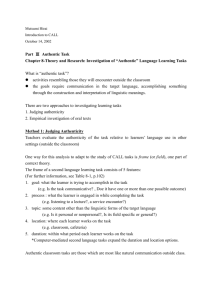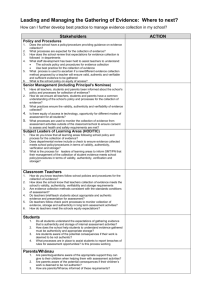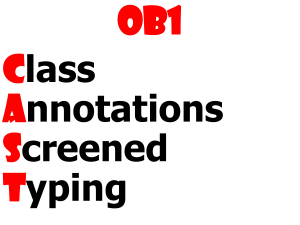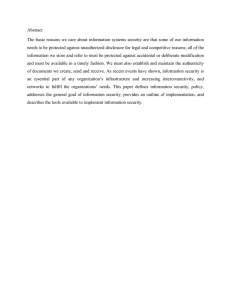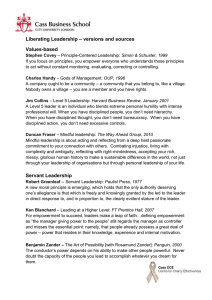Text and task authenticity in the EFL classroom
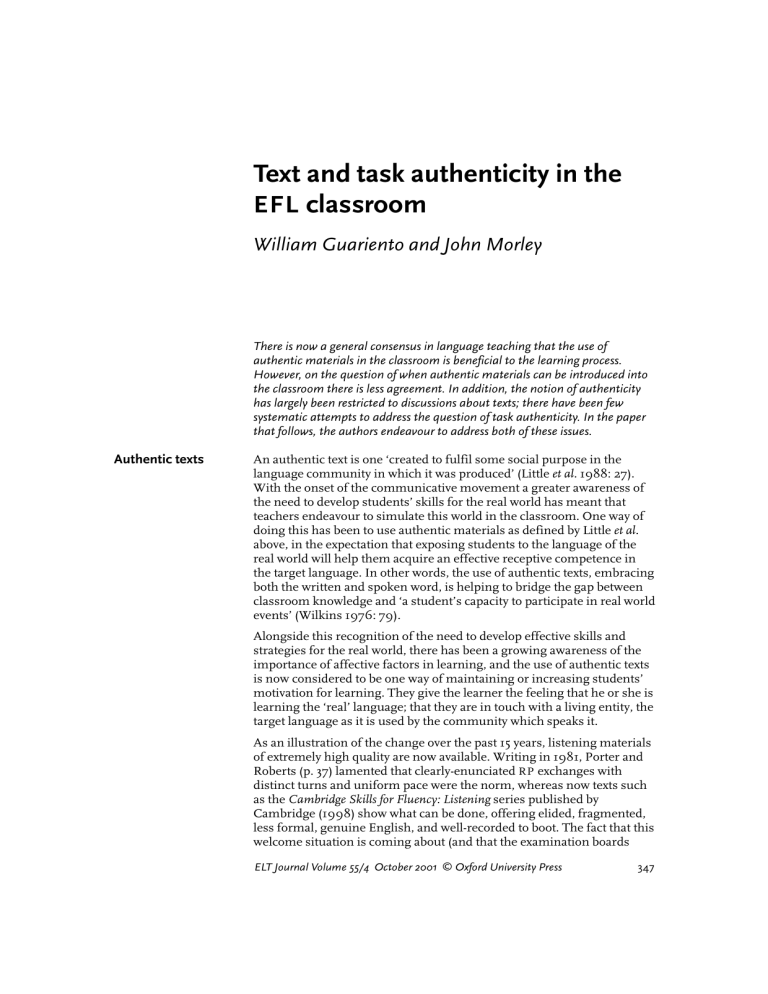
Text and task authenticity in the
EFL
classroom
William Guariento and John Morley
Authentic texts
There is now a general consensus in language teaching that the use of authentic materials in the classroom is beneficial to the learning process.
However, on the question of when authentic materials can be introduced into the classroom there is less agreement. In addition, the notion of authenticity has largely been restricted to discussions about texts; there have been few systematic attempts to address the question of task authenticity. In the paper that follows, the authors endeavour to address both of these issues.
An authentic text is one ‘created to fulfil some social purpose in the language community in which it was produced’ (Little et al.
1988: 27).
With the onset of the communicative movement a greater awareness of the need to develop students’ skills for the real world has meant that teachers endeavour to simulate this world in the classroom. One way of doing this has been to use authentic materials as defined by Little et al.
above, in the expectation that exposing students to the language of the real world will help them acquire an effective receptive competence in the target language. In other words, the use of authentic texts, embracing both the written and spoken word, is helping to bridge the gap between classroom knowledge and ‘a student’s capacity to participate in real world events’ (Wilkins 1976: 79).
Alongside this recognition of the need to develop effective skills and strategies for the real world, there has been a growing awareness of the importance of affective factors in learning, and the use of authentic texts is now considered to be one way of maintaining or increasing students’ motivation for learning. They give the learner the feeling that he or she is learning the ‘real’ language; that they are in touch with a living entity, the target language as it is used by the community which speaks it.
As an illustration of the change over the past 15 years, listening materials of extremely high quality are now available. Writing in 1981, Porter and
Roberts (p. 37) lamented that clearly-enunciated RP exchanges with distinct turns and uniform pace were the norm, whereas now texts such as the Cambridge Skills for Fluency: Listening series published by
Cambridge (1998) show what can be done, offering elided, fragmented, less formal, genuine English, and well-recorded to boot. The fact that this welcome situation is coming about (and that the examination boards
ELT Journal Volume 55/4 October 2001 © Oxford University Press 347
Authenticity and text difficulty
An alternative
348 might take note of it) is largely in response to the importance of skillsdevelopment and motivational issues, as outlined above. The question now, it seems, is not whether authentic texts should be used, but when and how they should be introduced.
At post-intermediate level an ever-widening range of authentic material has become available for use in the classroom. It is generally possible to select texts that will stretch the learner in terms both of skills development and of the quantity and range of new language. And, of course, most texts are selected with this dual purpose in mind.
At lower levels, however, even with quite simple tasks, unless they have been very carefully selected for lexical and syntactic simplicity and/or content familiarity/predictability, the use of authentic texts may not only prevent the learners from responding in meaningful ways but can also lead them to feel frustrated, confused, and, more importantly, demotivated. And this would seem to undermine one of the main reasons for using authentic texts in the first place.
So can authentic material be simplified without losing its authenticity?
Widdowson (1978) believes that simplification can take place, within the conventions of a given language field, while maintaining authenticity in the sense of learner response. To do this, the text has to ‘engage the learner’s interest and impress him as being in some way relevant to his concerns’ (ibid.: 90). At lower levels, therefore, as long as this can be achieved, the genuine/specially-prepared dichotomy is perhaps irrelevant. Simplification is fine. Materials do not have to be given an artificial ‘genuine-look’ in order to be accepted by the learner. What matters more is that they should be well-executed. As Lynch (1996: 15) puts it, ‘simplification—that is successful simplification—contributes both to the current communicative event and to longer-term language development’. The suspicion remains, however, that many textbook writers make recourse to simplification with a haste that is often undignified. The resulting texts are patently not ‘well-executed’. In writing, technical and sub-technical words are excised (and with them any clues to context); in listening, texts lose their redundant features and are shortened (and hence lose the repetitions upon which L 2 learners so depend), or the co-ordination of natural speech gives way to subordination, in the name of efficiency. While simplification of text, especially for lower levels, is justified, it appears to be difficult to execute seamlessly.
An alternative approach to the problem does exist. We have already seen how real text can help ‘bridge the gap between the classroom and the real world’. A corollary of this has been that partial comprehension of text is no longer considered to be necessarily problematic, since this is something which occurs in real life. As long as students are developing effective compensatory strategies for extracting the information they need from difficult authentic texts, total understanding is not generally held to be important; rather, the emphasis has been to encourage students to make the most of their partial comprehension.
William Guariento and John Morley
A well-known example of such a kind of listening is Porter and Roberts’ distorted railway station message, from which students have to predict and then extract specific information (1981: 44). Asking students to work in a similar fashion, Windeatt (1981), cited in Anderson and Lynch
(1988: 88) explains how the same listening text can be used with six different learner levels. In developing these strategic competencies, texts do not, therefore, need to be simplified; it is what learners are expected to do with the texts that has to be controlled.
Nevertheless, whilst some texts lend themselves to this kind of competence training, few teachers would agree that all textual input should only be exploited in this way. For one thing, we should be aware that it offers reduced opportunities for introducing learners to comprehensible input, and ultimately (as we have seen), it may also lead to learner frustration at lower levels. It can also give rise to the use of non-authentic tasks, with the concomitant loss of authenticity of learner response. When in real life, for example, do people listen to the news with the purpose of noting down how many items are covered? (This is one of Windeatt’s tasks.) It is to this issue of task authenticity, specifically as it relates to productive tasks, that we will now turn.
The importance of task
‘Control over linguistic knowledge is achieved by means of performing under real operating conditions in meaning-focused language activities’ (our italics).
(Ellis 1990: 195)
Taking the Ellis quote above, we might posit that ‘authenticity’ lies not only in the ‘genuineness’ of text, but has much to do with the notion of task. In fact, there is growing evidence that whilst input is necessary for the development of proficiency in the target language, by itself it is not sufficient. A degree of instruction or focus on form (Long 1991), together with learner production, are now generally considered important for classroom-based second language development. Pedagogic tasks provide a means of giving learners opportunities for production (Swain 1985) and opportunities to draw attention to aspects of form in the target language (Willis 1996, Skehan 1998). If this is the case, it might be useful to consider whether the notion of authenticity can be applied to pedagogic tasks, as we have already applied it to pedagogic texts, in any useful way.
The issue of task authenticity is in fact far more complex than Ellis’s rather vague reference to ‘real operating conditions’, and so it might be possible to identify four broad schools of thought regarding task authenticity:
1 Authenticity
One of the crucial aspects of task authenticity is whether real
through a genuine
communication takes place; whether the language has been used for a
purpose
genuine purpose. Willis (1996) is keen to distinguish these kinds of activities, which she calls tasks, from activities where the language learners are simply producing language forms correctly. Grammar exercises, drills, and practice activities in which the emphasis is on a particular linguistic form, are all examples of the latter. In tasks, on the
Text and task authenticity in the EFL classroom 349
other hand, the emphasis should primarily be on meaning and communication, and this is something which replicates the process of communication in the real world. In this kind of interaction, Willis
(1996: 18) argues, students have the chance to interact naturally, in ‘real time’, to achieve a particular communicative goal, which will be ‘far more likely to lead to increased fluency and natural acquisition’ than controlled exercises that ‘encourage learners to get it right from the beginning’.
2 Authenticity
Working within a needs-analysis framework, Long and Crookes (1992)
through real world
argue that pedagogic tasks must relate to ‘real world’ target tasks.
targets
Examples that they give are: buying a train ticket, renting an apartment, reporting a chemistry experiment, taking lecture notes, and so forth. The target tasks are identified following a needs analysis of the tasks which the learners are preparing to undertake. The classroom-based pedagogic tasks are not the same as the target tasks, but ‘complex approximations of them’ (ibid.: 44). From this perspective, a task might be said to be authentic if it has a clear relationship with real world needs. At this point we should remind ourselves that the identification of needs is not necessarily simple; Fanselow (1982: 180) shows that caution is required, citing the case of a Chinese chef who has been taught to describe his work as he goes about it. At first sight, since this field has been identified correctly, this might seem to satisfy Long and Crookes’ definition of authenticity, but does it really do so? Does a Chinese chef need to be able to say ‘I am slicing the onions’? S/he might well be better off learning how to take a telephone order, or to check figures on an invoice. And if authenticity in terms of content is elusive in ESP , how much more so on a general English course?
3 Authenticity
Rather than focusing on real world situations outside the learning
through classroom
situation, Breen (1985) argues that the most authentic activities exploit
interaction
the potential authenticity of the learning situation: ‘Perhaps one of the main authentic activities within a language classroom is communication about how best to communicate’ (ibid.: 67). Breen argues that all of the everyday procedures, the learning tasks, types of data, and the materials to be selected and worked on, the actual needs, interests, and preferred ways of working of all the people gathered in the classroom, all provide
‘sufficient authentic potential for communication’ (Breen 1985: 67). So for Breen, it is important that the choice and sequence of tasks are negotiated, and it is this very process of negotiation which is authentic.
One of the examples he gives is of students working in pairs and groups, and discussing, evaluating and reporting on the usefulness and appropriateness of teacher feedback and different kinds of homework tasks.
4 Authenticity through engagement
Finally, mirroring Widdowson’s concern with learner response to text, authenticity of task might be said to depend on whether or not a student is ‘engaged’ by the task. Just as ‘genuine’ materials may seem inauthentic to certain groups of learners, so tasks which are authentic by any of the above criteria can appear inauthentic to certain learners.
Ultimately, this is probably the most crucial type of authenticity, for unless a learner is somehow ‘engaged’ by the task, unless they are
350 William Guariento and John Morley
Authenticity and task difficulty
genuinely interested in its topic and its purpose, and understand its relevance, then the other types of authenticity may count for very little. It also has important implications for the presentation and selection of tasks. It may be possible, for example, to ‘authenticate’ a task to learners through careful explanation of its rationale. Further, echoing Breen’s concern that the learning should be the product of negotiation, it suggests that students should be given a role in task selection.
At first, the four types of task authenticity presented above might not seem to have much in common. Long and Crookes’ concern that pedagogic tasks must relate to target tasks appears to be at odds with
Breen’s notion of achieving authenticity by exploiting the communicative potential of the immediate learning situation. And, while Breen sees negotiation of the learning process as an authentic task, this may appear inauthentic to certain types of learner. Nevertheless, as a guiding principle, we think that each of the four notions described above, has much to offer the practising teacher and/or materials designer, and of course, ultimately, the student. Furthermore, while all four may not form a coherent whole, teachers can, in appropriate circumstances, devise learning situations in which the four can operate in conjunction. For example, a class might negotiate a series of communicative learning tasks which all, in some way, approximate real world target tasks. This could then be followed by a post-task discussion of the value/usefulness of each activity.
Let us now consider whether task authenticity need be compromised when we are working with low level students. Careful consideration of the elements comprising task difficulty (which Skehan (1998) has usefully identified as complexity of the language, cognitive load, and performance conditions) should lead to selection of tasks in accordance with students’ ability, but tasks which are relatively simple need not be deemed any less authentic than more difficult tasks. Willis (1996), for example, is a useful source of genuinely communicative activities which can be used with beginners and young learners. Many of these activities are games, or have a game quality about them, for example, such as playing bingo, remembering items from a picture, playing verbal hide and seek, finding the odd word out of a series. Others involve obtaining real information by conducting simple surveys in the class, for example, such as making a list of class telephone numbers, finding out what makes of car the other students have, or about members of their families.
If approximation to real world target tasks is our concern, then many examples of authentic but simple tasks come to mind, including one of the examples already mentioned by Long and Crookes: buying a train ticket. We could add, for instance, ordering a coffee, booking a hotel room, or asking the way. Breen’s call for teachers to devise tasks which exploit the ‘communicative potential of the classroom’ might seem too ambitious for low-level students who cannot be expected to engage in complex discussions and negotiation about the learning situation. But, even at very low levels, there is still some scope for genuine student input into the teaching–learning process. For example, low-level students may make useful contributions to course evaluation through the use of
Text and task authenticity in the EFL classroom 351
Conclusion
simple questionnaires and class surveys. Such methods become useful for taking into account students’ perceptions of task usefulness and future relevance, which we identified earlier as the fourth kind of authenticity. And surely this is something that most of us would agree can and should operate at all levels of student proficiency?
The above discussion suggests that considerations of authenticity bear little relation to their degree of difficulty. Very simple pedagogic tasks used with low-level students can still be described as authentic.
In this paper we have argued that the authenticity of texts (genuineness) may need to be sacrificed if we are to achieve authentic responses in our students. Although examples were given of how certain real texts can be used with very low learners, a strong case was also made for the wellexecuted simplification of texts. In contrast, we have seen how many very simple tasks can be devised which exhibit a high degree of authenticity, not only in terms of task, but also in terms of learner response.
We expect that many readers will already have realized that the separation between text and task maintained thus far is a rather artificial one; in the real world, language input and language output usually occur as part of an integrated process of communication. Current practice in language teaching recognizes this, and so texts, in addition to introducing new language and developing receptive competence, are generally used as stimuli for tasks. Preliminary tasks, too, can have an important role prior to students’ work with a text. To do this, to integrate input and output, reception and production, is to mirror real world communicative processes, and is something that all teachers concerned with moving towards authenticity should aim to do.
Revised version received April 2000
References
Anderson, A.
and T. Lynch.
1988. Listening. Oxford:
Oxford University Press.
Breen, M. P.
1985. ‘Authenticity in the language classroom’. Applied Linguistics 6/1:
60–8.
Ellis, R.
1990. Instructed Second Language
Acquisition . Oxford: Blackwell.
Fanselow, J.
1982. Breaking Rules.
London:
Longman.
Little, D., S. Devitt, and D. Singleton.
1988.
Authentic Texts in Foreign Language Teaching:
Theory and Practice.
Dublin: Authentik.
Long, M. H.
1991. ‘Focus on form: A design feature in language teaching methodology’ in
K. de Bot, R. Ginsberg, and C. Kramsch (eds.):
Foreign Language Research in Cross-Cultural
Perspective.
Amsterdam: John Benjamins.
Long, M. H.
and G. Crookes.
1992. ‘Three approaches to task-based syllabus design’. TESOL
Quarterly 26/1: 27–47.
Lynch, T.
1996.
Communication in the Language
Classroom. Oxford: Oxford University Press.
Porter, D.
and J. Roberts.
1981 ‘Authentic listening activities’. ELT Journal 36/1: 37–49.
Skehan, P.
1998. A Cognitive Approach to Language
Learning. Oxford: Oxford University Press.
Swain, M.
1985. ‘Communicative competence: some roles of comprehensible input and comprehensible output in its development’, in S.
Gass and C. Madden (eds.): Input in Second
Language Acquisition.
Rowley: Newbury House.
Widdowson, H. G.
1978. Teaching Language as
Communication.
Oxford: Oxford University Press.
Willis, J.
1996. A Framework for Task-based
Learning.
London: Longman.
Wilkins, D.
1976. Notional Syllabuses.
Oxford:
Oxford University Press.
352 William Guariento and John Morley
The authors
William Guariento teaches EAP at the University of
Glasgow. He has an MA in Media Technology for
EFL from Newcastle University, and has previously worked in Italy, Eritrea, and the former
Soviet Union.
Email: W. Guariento@efl.arts.gla.ac.uk
John Morley is a lecturer in EAP at the University of Manchester. He has an MEd (Hons) from the
University of New England, and has previously worked in Australia, Singapore, Spain, and
Indonesia. His main interests are learner autonomy and genre analysis.
Email: john.morley@man.ac.uk
Text and task authenticity in the EFL classroom 353

